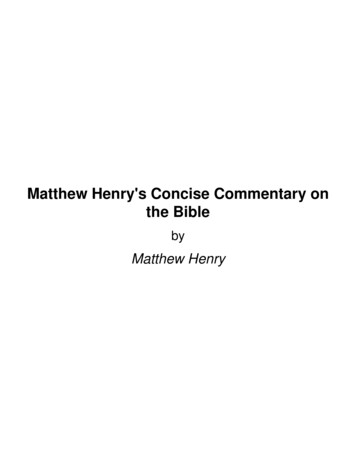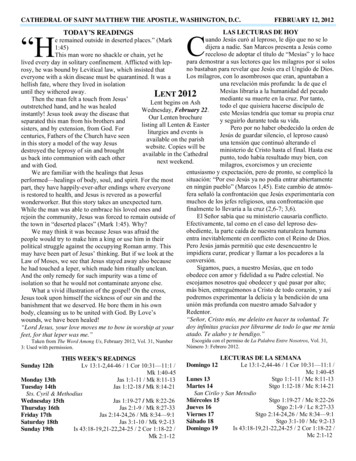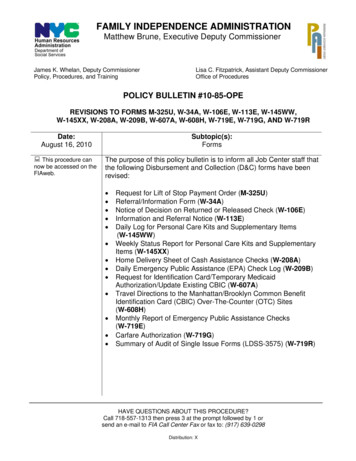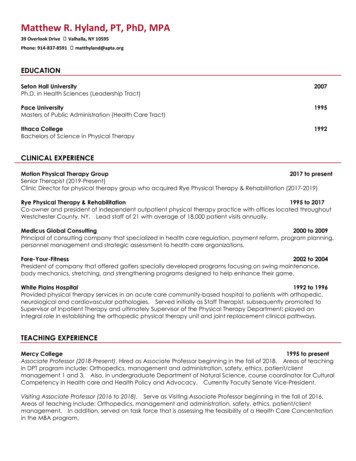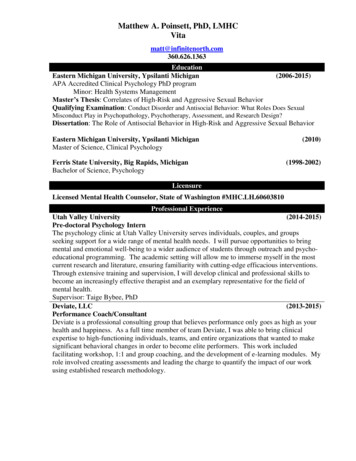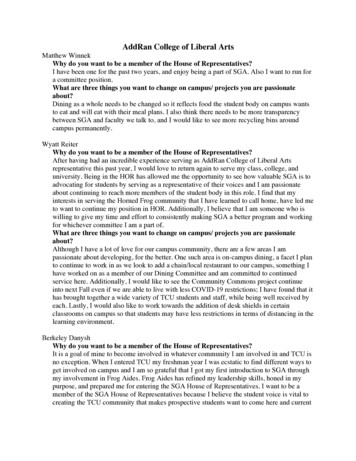
Transcription
Mohato Lekena & Matthew KrogProject ProposaliMobile: Redesigning the mobile interface
Page 2Table of Contents12345678Project Description .3Problem statement .32.1Data organization .42.2Data Retrieval .42.3Research questions: .4Related Work .5Procedures and Methods .54.1Development Platform.54.2System Design .54.3Expected Challenges .64.4Testing and Evaluation.6Ethical, Professional and Legal Issues .6Anticipated outcomes .76.1System.76.2Expected Impact .76.3Time Ordered Views vs. Hierarchical Filing .76.4Associative Querying vs. Files/ Linear search .76.5Key Success Factors .8Project Plan .87.1Risks .87.1.1Hardware Failure .87.1.2Conflict between Group Members .87.1.3Group members leaving .97.1.4Failure to obtain Ethical Permission .97.2Resources Required .97.3Gantt Chart .97.4Milestones.97.5Work Allocation .9References .10iMobile: Redesigning the Mobile Interface
Page 31 ProjectDescriptionThe aim of this project is to investigate analternative interface for the mobile platform.Thus far, most mobile interfaces havesimply been adaptations of the rformtasks andhierarchical file structures to organiseinformation [1][2].The new interface that is to be developedwill shift focus away from the desktopmetaphor, and instead look at developing amore natural way for users to interact withtheir personal information. This will be doneby developing a prototype interface thatruns on Android enabled smart phones.Particular focus will be on novel ways ofrepresenting information organisation andinformation retrieval. A mobile adaptation ofthe Lifestreams [2] desktop system will beused for information organisation, makinguse of a unified inbox and organising databy time. Search will form a fundamental partof the interface and an associative querysystem similar to Feldspar [3] will act as thebackbone for information retrieval.This new interface is to be evaluatedagainst traditional application orientedmobile user interfaces such as those ofiPhone and Android.iMobile: Redesigning the Mobile Interface2 ProblemstatementThe hierarchically organized, applicationbased desktop metaphor used on manyuser interfaces today has been shown manytimes to be an ineffective way of bothorganizing and retrieving data [1][4][5].When the same concepts were then portedto be used also on mobile computingdevices the same problems remained, andactually became worse. This worsening wasdue to the fact that there lay many inherentdifferences between mobile and stationarycomputing devices [6] [7]. However, at adesktop level, many of these problems wereinvestigated and solutions were given in anattempt to replace these outdated ideas(see related work section). Unfortunately,none of these systems or concepts has yetbeen actualized on a mobile level. What theresearch proposed in this paper aims to dois to investigate how successful these ideasfrom previously proposed systems would bewhen implemented on a mobile system as asingle-user interface. This new interfacewould, once created, completely replace allthe data organization and retrieval tasksalready performed on the devices in a nonapplicationspecific,non-hierarchicallystored way. Instead, the system wouldimplement ideas mainly stated in twoseparate papers—the Lifestreams [2] userinterface and the Feldspar [3] searchinterface. These look, respectively, at theinter-dependant yet separate areas of dataorganization and data retrieval.
Page 42.1 Data organizationFor data organization, the central idea thatdesigns will revolve around is that of theStream. A Stream is a virtual area on theuser’s device where all their data is stored,regardless of application type. The streamwould then be ordered by time, with newitems entering the system being placed nearthe front of the stream and older items thenbeing pushed towards the back. Furtherorganization would be achieved via theimplementation of constructs called views,which are inspired by the Haystack system[8].Theseviewsarepersistentvisualizations of data filters which aredefined by the user. Any new or existingdata fitting into the filter’s criteria would thenbe displayed in its view. These views wouldalso be applicationindependent and time ordered, and wouldact as the primary filing system – essentiallyallowing for data organization using userdefined criteria. Although singular itemscould also be added or removed to anysingle view, and multiple views will be ableto be split or merged, the main method forcreating views will be through asophisticatedquerying method.Thisquerying method is explained further belowas the data retrieval.2.2 Data RetrievalAn important feature seen in many of thesystems proposed as new paradigms forcomputer interfaces (such as lifestreams) issearch based data retrieval. For this reasonit can be seen that having an effectivesearch query construction interface is animportant aspect of this new interface. Thepaper from which this project will be drawinginspiration and from which will beiMobile: Redesigning the Mobile Interfaceimplemented on the mobile interface is theone describing the Feldspar AssociativeQuery System. Feldspar is a desktop querysystem that uses associative retrieval ofpersonal information [3]. Feldspar takes thephilosophy that people remember things byassociation and uses an orienteeringapproach to retrieve information, allowingusers are able to specify multiple queries torefine their search. When implemented onthe mobile interface a linking system, asseen in the Life Ideas [15] paper, will alsobe integrated. This would allow the user tobrowse through related sets of documents,with relations being worked out from tagsand other textual information.2.3 Research questions:On implementing this system which wouldincorporate the above mentioned proposedsolutions, the research questions which willbe investigated will thus be:1. a) Can a time ordered user interface withuser defined contextual organizing based onthe Lifestreams system be implementedsuccessfully on a mobile platform?1. b) If so, would it be preferable (withpreferability being defined xxbelowxx)?2. a) Can associative query based dataretrieval system based on the Feldsparsystem be implemented on a mobileplatform?2. b) If so, is it preferable?
Page 53 Related WorkQuery systems can be divided into twotypes, orienteering and teleporting [11].Orienteering is the most natural user searchbehavior and involves refining searchresults through a series of iterative querysteps until the target result is reached.Searching the web and querying personalinformation are different. When queryingpersonal information, the user hasknowledge about the data they aresearching for and is familiar with the searchresults that are displayed [12] [13]. Anumber of query systems including Life-Idea[15], FaThumb [14], Stuff I’ve Seen (SIS) [9]and Feldspar [10] were looked at. Of thefour query systems examined, Feldspar wasfound to be the most suitable. Feldspar is adesktop personal information managementsystem that is centered around associativesearch. The user is given hints or clues asto the type of data that they may searchusing. The use of simple language linksmakes building query phrases intuitivelyeasy. In terms of the data organisationaspect of the project, only [2] and [8] havetried to implement similar ideas, but only atthe desktop level. On mobile devices theimplementation will be extremely novel.4 Procedures andMethods4.1 DevelopmentPlatformThe system will be developed on thecurrently popular Android platform. AndroidiMobile: Redesigning the Mobile Interfacephones are currently on the rise, withGoogle - who manufacture the phones claiming that 200 000 Android enabledphones are sold daily. Development on thephone is done entirely in the Javaprogramming language, with Androidspecific classes and functions beingavailable through the Android SoftwareDevelopment Kit (SDK) and AndroidDevelopment Tools (ADT). These provide acomprehensive set of functionality to aiddevelopment including, amongst otherthings, debuggers, libraries and a computerbased mobile phone emulator. The t (IDE) is Eclipse, which isavailable most major operating systems.4.2 System DesignAs mentioned earlier, the interfaceprototype will consist of two components;the information retrieval system (or querysystem) and the information organisationsystem. The information query system willbe based on the Feldspar desktop ty. Users are able to build queriesbased on associative clues or hints. Theuser then has the ability to refine searchesusing multiple queries.The data organisation system will be animplementationofLifestreams.Allinformation will be stored in a unified inboxordered by time (with recently used itemsappearing first). This information will then beable to be filtered using the underlyingquery system. Popular queries and filterscan be saved and used as an organisationalfeature.
Page 64.3 Expected ChallengesDue to time constraints, it will not bepossible to implement a fully-fledgedworking implementation of the Lifestreamsand Feldspar systems on a mobile platform.The main focus will thus be to build anapplication that conveys the feeling of theinterface. That is, to provide enoughfunctionality for the user to get a goodfeeling for how the system is supposed towork. Ultimately allowing users to be able tocompare and test it against other systems.Due to constraints of the mobile device suchas screen size, the Lifestreams andFeldspar systems may very well need to beadapted to make them operable on asmartphone. The interface that is developedfor the mobile may end up lookingcompletely different to the desktop version.While this is fine, it is important that theconcepts adapted from the desktop systemare still present.4.4 Testing andEvaluationThis is an experimental computer scienceproject, with one of the main goals being todetermine whether a non-applicationoriented mobile interface is more useful andpreferable to users than an applicationoriented mobile interface. It is thus veryimportant that once the interface prototypehas been developed, extensive user testingis carried out. The newly developedinterface will be compared to two traditionalapplication oriented mobile interfaces,namely, iPhone and Android.Satisfaction with the various systems will bedetermined using questionnaires andiMobile: Redesigning the Mobile Interfaceinterviews with users. The qualitative datagleaned from these methods should provideinsight into user preferences and anindication as to which is the overallpreferred system.Quantitative data such as the time taken tocomplete a set task and the number ofsteps or key presses required to completethat task will also be recorded. Thisinformation should indicate the system thatprovides the user with the most rapidresults.Since the newly developed system may beforeign to many users, this may affectperformance. Users using a system for thefirst time may not be familiar with how thingswork
Development Kit (SDK) and Android Development Tools (ADT). These provide a comprehensive set of functionality to aid development including, amongst other things, debuggers, libraries and a computer based mobile phone emulator. The officially supported integrated development environment (IDE) is

